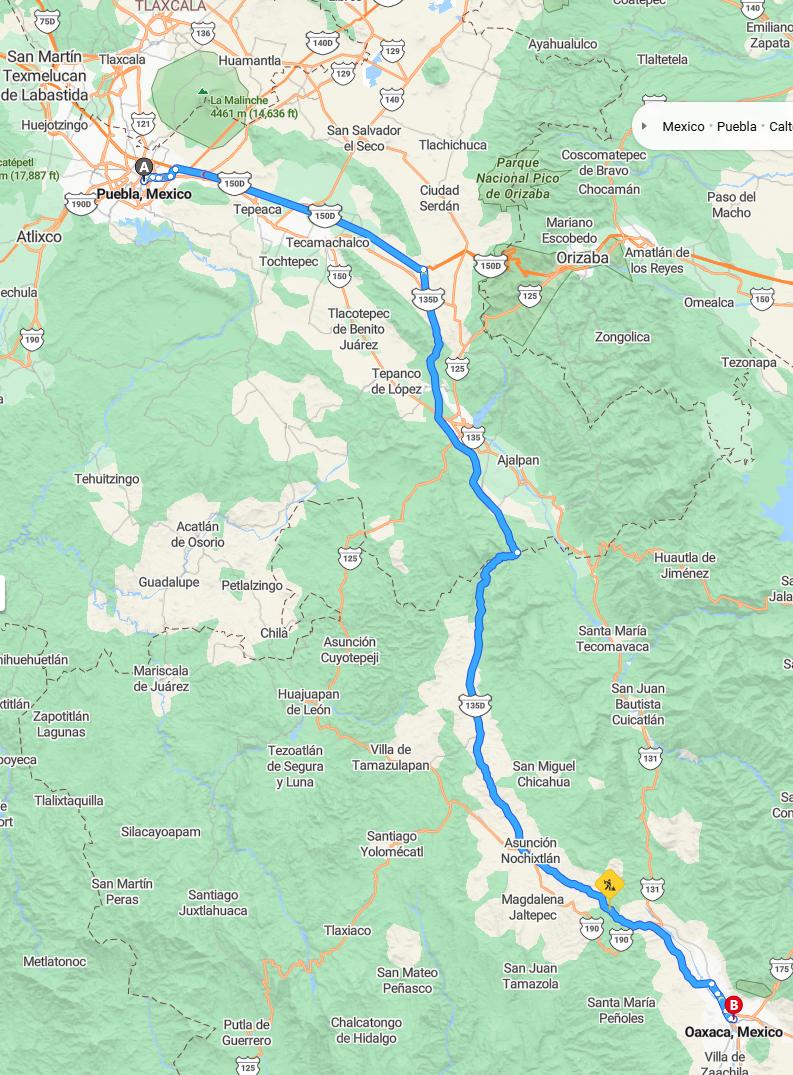Distance and estimated driving time
The drive from Puebla to Oaxaca covers approximately 209 miles and typically takes around 3 hours and 56 minutes. The journey primarily follows major highways MEX-150D and MEX-135D, offering a relatively straightforward route through scenic landscapes. Travelers can expect a smooth journey with well-maintained roads, making it an ideal trip for those exploring southern Mexico. Planning ahead for potential stops and traffic can help ensure a comfortable and efficient travel experience.
Driving route
Embarking on a scenic drive from Puebla to Oaxaca, travelers pass through charming towns such as San Salvador el Seco, Tlachichuca, and Tecamachalco, each offering unique cultural and historical insights. The route continues through Tochtepec, Tepanco de Lopez, and Ajalpan, showcasing the diverse landscapes and vibrant communities of the region. As the journey progresses, visitors can explore Magdalena Jaltepec and Santa Maria Penoles, local sites rich in tradition and local craftsmanship. The journey culminates in the vibrant city of Oaxaca, renowned for its indigenous heritage, colorful markets, and inspiring architecture. This route provides an enriching experience filled with natural beauty and cultural diversity across central Mexico.

Best time to travel
The optimal time to travel from Puebla to Oaxaca is during the dry season, which spans from November to April, providing favorable weather conditions and clearer roads. Traveling in this period ensures a safer and more comfortable journey, with minimal rain disruptions and lush scenic views. The months of December through February are particularly popular, thanks to cooler temperatures and festive festivities in Oaxaca. To avoid peak tourist crowds and higher prices, consider early mornings or weekdays within this timeframe for a more relaxed trip.
Road conditions and safety tips
The drive from Puebla to Oaxaca features a variety of road conditions, including well-maintained highways and some narrow rural stretches. Travelers should exercise caution on winding mountain routes, especially in the Tlachichuca and Santa Maria Penoles areas, where sudden turns and steep inclines are common. To ensure safety, it is advisable to drive at appropriate speeds, stay alert for changing road surfaces, and avoid nighttime travel in less developed sections. Additionally, keeping emergency supplies in the vehicle and staying informed about local weather conditions can help ensure a safe and smooth journey.
Toll booths and costs
When driving from Puebla to Oaxaca, travelers will encounter several toll booths along the route, primarily managed by Mexico's federal highway system. The toll costs vary depending on the section; typically, motorists can expect to pay around 200 to 300 pesos for the entire journey, with additional fees at specific toll plazas such as those near Tlachichuca and Tecamachalco. It is advisable to carry cash in Mexican pesos, as some toll booths accept only cash payments. Overall, budgeting for tolls ensures a smooth trip, allowing travelers to enjoy the scenic drive through towns such as San Salvador el Seco and Santa Maria Penoles to their vibrant destination in Oaxaca.
Recommended rest stops
When driving from Puebla to Oaxaca, it is advisable to plan rest stops at key towns along the route for relaxation and refreshment. San Salvador el Seco and Tlachichuca are convenient options to stretch your legs and enjoy local cuisine. Tecamachalco and Tochtepec offer additional opportunities to rest, refuel, and explore cultural sites. Taking breaks at these points ensures a safer, more enjoyable journey through the scenic landscapes of Mexico.
Scenic attractions along the route
Traveling from Puebla to Oaxaca offers a variety of stunning scenic attractions that showcase Mexico's rich natural beauty and cultural heritage. Along the route, San Salvador el Seco features picturesque views of lush agricultural landscapes, while Tlachichuca is known for its proximity to the majestic Iztaccihuatl and Popocatepetl volcanoes, offering breathtaking mountain vistas. Tecamachalco and Tepanco de Lopez provide charming rural scenery with vibrant local markets and colonial architecture, inviting travelers to experience authentic Mexican culture. Finally, as you approach Oaxaca, the lush greenery and vibrant hillside communities create a captivating backdrop that highlights the region's unique blend of nature and tradition.
Vehicle requirements and regulations
Traveling from Puebla to Oaxaca requires ensuring your vehicle complies with local regulations, including valid registration and insurance. It's important to carry necessary documentation such as your driver's license, vehicle permit, and proof of insurance, as police frequently check these at checkpoints. Additionally, vehicles should be in good condition, with functioning lights, brakes, and tires, to meet safety standards. Adhering to speed limits and road signs along the route helps ensure a safe journey through towns like San Salvador el Seco, Tlachichuca, and Tecamachalco.
Local traffic laws and driving tips
When driving from Puebla to Oaxaca, it is important to obey local traffic laws, including speed limits and signage, which can vary between towns and rural areas. Always carry necessary documents such as your driver's license, vehicle registration, and insurance, as checkpoints may occur along the route. Be cautious of local driving habits, especially in smaller towns where traffic flow might be less regulated, and exercise patience in crowded or narrow areas. Additionally, take note of typical road conditions, including possible gravel or uneven surfaces, and plan for refueling stops in larger towns like Tlachichuca and Tecamachalco to ensure a smooth journey.
Fuel stations and availability
Traveling from Puebla to Oaxaca, fuel stations are readily available along the route, especially in larger towns such as Puebla, San Salvador el Seco, Tlachichuca, and Oaxaca City. Most of these stations offer a variety of fuel options, including regular and premium gasoline, ensuring convenient refueling stops throughout the trip. In smaller towns like Tecamachalco, Tochtepec, and Tepanco de Lopez, fuel stations are less frequent but generally still accessible, often operated by local providers. It is advisable to refuel in larger towns to avoid potential shortages in more remote areas and ensure a smooth journey.
